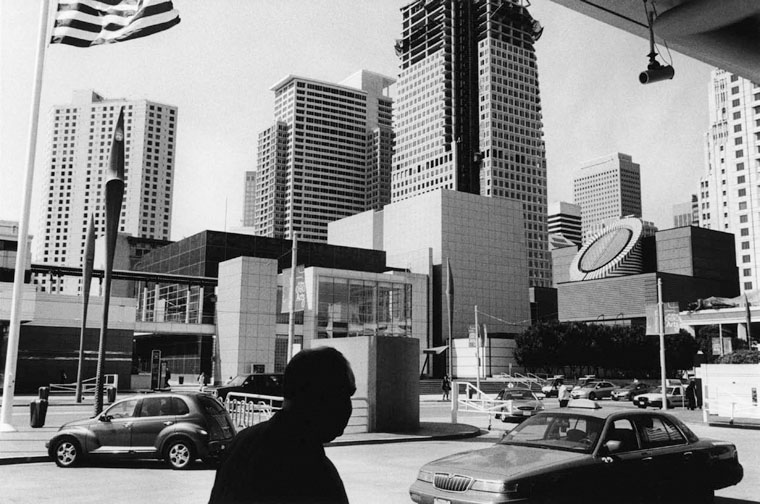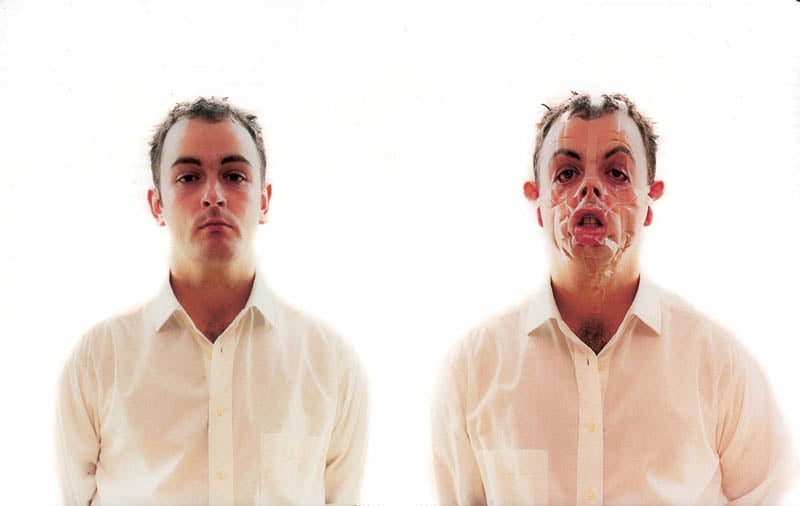
© » KADIST
Richard Gordon
Washington D. C. Constitution Ave. is a silver gelatin print from the series American Surveillance , a ten-year-long project where Richard Gordon photographed surveillance cameras across USA. In the image, a woman and a child walk along Constitutional Avenue as a surveillance camera on the street post directs its gaze towards them. The otherwise quiet image then becomes an exercise of resistance: together with the other images from the series, Gordon’s photograph documents the changes that have taken place in architecture, civic life, especially in a post 9/11 experience of public space.

© » KADIST
Richard Gordon
San Francisco, Moscone Center is a silver gelatin print from the series American Surveillance , a ten-year-long project where Richard Gordon photographed surveillance cameras across USA. In the image’s foreground we see the silhouette of a man, darkened and in contrast to the bright streetscape unfolding behind him. To the left, an American flag flutters in the wind, saluting the skyscrapers—among them the iconic architecture of the San Francisco Museum of Modern Art.

© » KADIST
Richard Bell
For Richard Bell, art is not simply a vehicle through which to represent and convey political content. On one hand, art itself has an activist charge—in its very form and presence it can shake up conventional or assumed understandings, opinions, and behaviours. But on the other hand, it is deeply implicated in the actions and attitudes associated with colonialism in Australia and abroad.

© » KADIST
Douglas Gordon
In Monster (1996-97), the artist’s face becomes grotesque through the application of strips of transparent adhesive tape, typical of Gordon’s performance-based films that often depict his own body in action. Also characteristic of his work, the scene takes place in front of a mirror, suggesting the kind of personal self-reflection that one is capable of – both good and evil. The video makes clear cinematographic reference to the ‘alter-ego’ transformation in Mamoulian’s Dr. Jekyll and Mr. Hyde, and to the “You looking at me?” sequence performed in front of a mirror by Robert De Niro in Scorsese’s Taxi Driver which also inspired Gordon’s through a looking glass ( 1999).

© » KADIST
Douglas Gordon
Douglas Gordon’s single-channel video The Left Hand Can’t See That The Right Hand is Blind, captures an unfolding scene between two hands in leather gloves—at first seemingly comfortable to be entwined, and later, engaged in a struggle. As suggested by the work’s title, each of the hands assumes a character with a distinct personality, as if we were witnessing a lovers’ quarrel and embrace, or the embodiment of opposing forces of an internal struggle. Gordon has previously created performance-based works depicting his own body or parts of it—arms, hands, fingers, eyes—usually enacting simple, repetitive movements.

© » KADIST
Douglas Gordon
Blind Spencer is part of the series “Blind Stars” including hundreds of works in which the artist cut out the eyes of Hollywood stars, in a symbolically violent manner. An emptiness (some are burned letting appear a white or mirror background or a mirror) replaces the eyes, giving the impression of a blind eye deprived of all expression. Paradoxically, the work looks at us all the more intensely.

© » KADIST
Leah Gordon
The Caste Portraits Series by Leah Gordon investigates the practice of grading skin color from black to white, which marked the extent of racial mixing in 18th century Haiti. Médéric Moreau de St Mery (1750-1819), a French créole slave owner and freemason living in Saint Domingue (now Haiti), created a taxonomy of race classifying skin color from black to white using names derived from mythology, natural history, and bestial miscegenation. His Description topographique, physique, civile, politique et historique de la partie française de l’isle Saint-Domingue (1789) hierarchizes 128 possible combinations of black-white miscegenation into nine categories (the sacatra, the griffe, the marabout, the mulâtre, the quarteron, the métis, the mamelouk, the quarteronné, and the sang-melé).

© » KADIST
Richard T. Walker
let this be us is a single-channel video by Richard T. Walker featuring the artist himself roaming around the wilderness of a deserted landscape, sporadically humming a melody, strumming a guitar, or playing a few notes on a keyboard. As he traverses between striking locations we see him carrying large photographic prints of the same landscape that he is treading, which he then rests onto tripods so that the horizon in the photograph seamlessly matches that of the real landscape. As we hear the music, Walker comes in and out of view, dissipating into the landscape as his body becomes invisible, hidden behind the photographic prints.
Douglas Gordon
- location: Berlin, Germany
- year born: 1966
- gender: male
- nationality: Scottish
- home town: Glasgow, United Kingdom
Richard Gordon
Originally from Chicago, Richard Gordon was a self-taught photographer best known for his intelligent and masterfully printed black-and-white photographs...
Richard T. Walker
- location: San Francisco, California
- year born: 1977
- gender: male
- nationality: British
Leah Gordon
Leah Gordon is an artist, curator, and writer, whose work considers the intervolved and intersectional histories of the Caribbean plantation system, the Trans-Atlantic Slave Trade, the Enclosure Acts and the creation of the British working-class...
Richard Bell
Richard Bell works across a variety of media including painting, installation, performance and video and text to pose provocative, complex, and humorous challenges to our preconceived ideas of Aboriginal art, as well as addressing contemporary debates around identity, place, and politics...
-
1990-1999
Douglas Gordon
1996In Monster (1996-97), the artist’s face becomes grotesque through the application of strips of transparent adhesive tape, typical of Gordon’s performance-based films that often depict his own body in action...
-
2000-2009
Douglas Gordon
2002Blind Spencer is part of the series “Blind Stars” including hundreds of works in which the artist cut out the eyes of Hollywood stars, in a symbolically violent manner...
Richard Gordon
2003San Francisco, Moscone Center is a silver gelatin print from the series American Surveillance , a ten-year-long project where Richard Gordon photographed surveillance cameras across USA...
Douglas Gordon
2004Douglas Gordon’s single-channel video The Left Hand Can’t See That The Right Hand is Blind, captures an unfolding scene between two hands in leather gloves—at first seemingly comfortable to be entwined, and later, engaged in a struggle...
-
2010-2019
Leah Gordon
2012The Caste Portraits Series by Leah Gordon investigates the practice of grading skin color from black to white, which marked the extent of racial mixing in 18th century Haiti...
-
2020-2029
Richard Bell
2022For Richard Bell, art is not simply a vehicle through which to represent and convey political content...